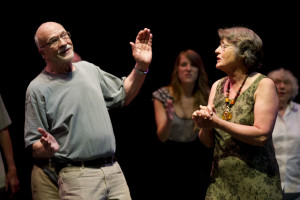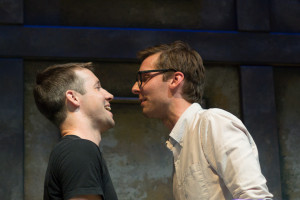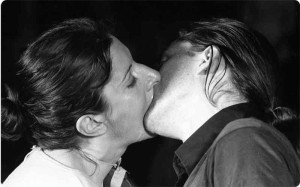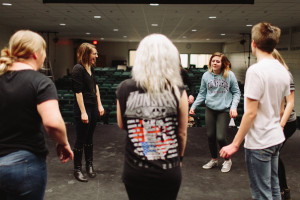Living in the Moment is Ageless
“I’m too old for that” is a statement I wish we could cut out of everyone’s vocabulary, including mine. As someone who essentially plays for a living, when I hear anyone say those words, I try to convince them otherwise.
You think you’re too old to take an improv class? Well, I can tell you from first hand experience, some of the most fearless improvisors I have ever worked with are in their 80s.
As you’re probably aware, the arts are being talked about more frequently as a way to improve the overall quality of life of older people. Taking part in a creative pursuit can by improve mood, memory, and physical health in our senior citizens. Plus, I believe art-making may be one of the best solutions out there for bringing generations together.
I began working with seniors through improv workshops put on by Edmonton’s GeriActors, Festival of Edmonton Seniors Theatre, and The Creative Age Festival. David Barnet, who was my professor at The University of Alberta, and is involved with these organizations, was a big part of why I got involved, and I am so thankful I did. He’s said to me in the past that it takes a certain type of person to work with seniors; someone with openness and flexibility, someone who can really to really let the performers’ voices shine through. He certainly achieves this in his work.
Leading workshops for senior citizens is one of the most rewarding experiences I have had in my career as an artist. Sure, there are challenges, like memory or mobility, but overall, leading a workshop for older people is just like leading one for any other age group. In fact, in some ways, it’s easier. Many of the seniors I met are in the enviable position of just not giving a fuck. They have lived so much life that the panic most people feel when doing improv for the first time just isn’t there. Like kids, they can just let go and be surprised. It is thrilling to watch a 90-year old woman do something unexpected.
Inspired by these workshops, I started collaborating on projects with my grandfather (my ‘Dido’), Nick Shostak, Senior. Well, maybe less collaborating, and more coercing him to help me. Through these projects, I have experienced different sides of him that I had never seen before, and watched him take creative risks.
In 2011, we did a piece called My Dido The Orator , as part of Latitude 53’s IN/STALL/ED. We recreated my Dido’s living room in a parking stall in the McCauley neighbourhood, and passersby stopped by to chat and hear his stories. My Dido was an absolute showman, laughing and engaging folks all day. One of the most impactful parts of the project was that the more stories Dido told, the more stories the audience started telling. At one point there were 10 or 15 people, sitting cross-legged on the ground of a parking lot, exchanging stories about coming to Canada, about politics, about the neighbourhood.
Then there was The Slow Flash Mob, which I put together in 2013. The focus of the event was to enliven a lovely, but often empty, park in Edmonton with intergenerational activities. This project was also an experiment for me, to explore the challenges a citizen might face trying to put on an event, as part of my work with Make Something Edmonton.
My Dido was the spokesperson for The Slow Flash Mob, and my friend Mike Robertson kindly helped us make a video to promote and raise funds for the event.
We also got to do an interview on TV. Dido seemed so excited to be at the station. He was curious about everything that was going on, talking to people who walked through the waiting area, and it was a rare moment where he seemed nervous. During our interview he seemed emotional, and made a great impression.
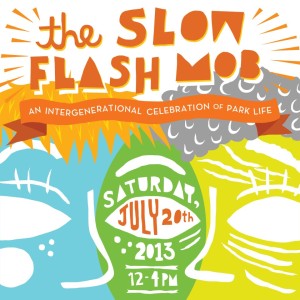 The Slow Flash Mob event itself came with its challenges; attendance was lower than I had hoped, the weather was spotty, and I received some feedback that the park I chose was too inaccessible for many senior citizens. But despite these issues, the people who did attend expressed how important the event was, and how much they appreciated it.
The Slow Flash Mob event itself came with its challenges; attendance was lower than I had hoped, the weather was spotty, and I received some feedback that the park I chose was too inaccessible for many senior citizens. But despite these issues, the people who did attend expressed how important the event was, and how much they appreciated it.
Most significantly to me though, my Dido showed up right on time. He had a nametag that he made for himself, that proudly said NICK. I watched him walk excitedly down the many wooden steps to the park. This was his party, and he was genuinely in his element. And god, that made me happy. To see someone in his 80s trying improv, tai chi, playing board games. His attitude is certainly the one I hope to have in my golden years.
All of these projects serve as a reminder that seniors find all the same things exciting as you and I (sex jokes, physical humour, flirting, donuts), and they are eager to engage, just like us. They are vibrant, funny, fierce individuals. More importantly, these experiences helped me articulate that there is a gap between our generations that we can close through collaboration, and this benefits anyone at any age in life.
If you’re looking for someone to jam on an idea, or are looking for volunteers or instructors to work with seniors, please get in touch! Improvisation for senior citizens is something I think every community should explore.

